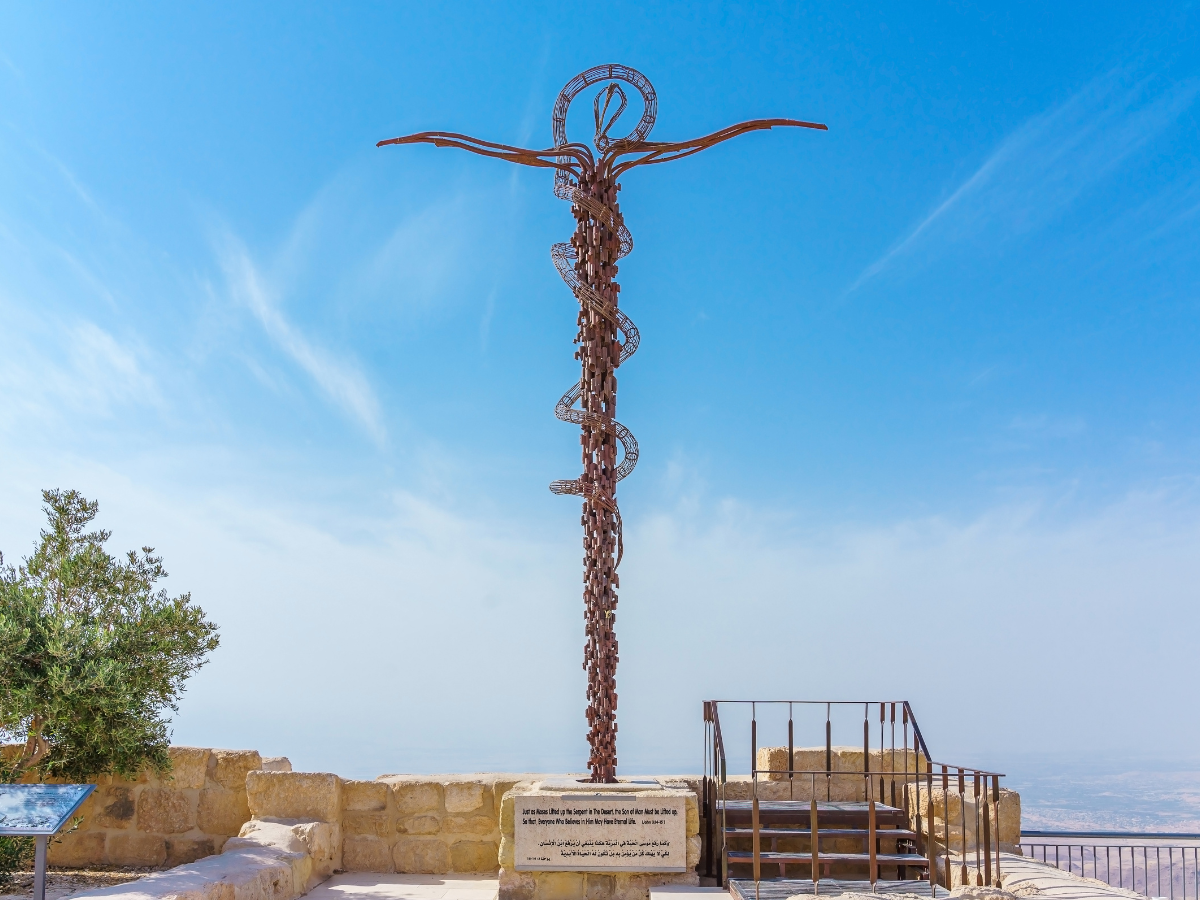Sunday, April 28, 2024 - John 15:1-8 Also Acts 8:26-40, Psalm 22:25-31, 1 John 4:7-21 Back in the winter of…
Symbols of Life
Sunday, March 10, 2024 – John 3:14-21, Also Numbers 21:4-9, Psalm 107:1-3, 17-22, Ephesians 2:1-10
There are a lot of wonderful themes in today’s reading. I could talk about light, and I’m sure there will be sermons about light, but today I want to talk about snakes. I have to admit, I am interested in snakes. In truth, I love talking about what a snake or serpent might mean symbolically. I don’t dislike real snakes at all – I actually love when I encounter the nonpoisonous black snakes I sometimes see in the garden, or the beautiful yellow eastern rat snake I saw near a dumpster a year or so ago.
Serpent as Symbol
But ever since I had a very vivid and meaningful snake dream, I’ve been fascinated with them as a symbol. And symbols or images are the way that humans receive guidance and inspiration from the depths of Life. That snake dream occurred in the year before I began my theological education at the Lutheran School of Theology at Chicago. So, when I was in my first semester, I wrote a paper on the story of the Garden of Eden because I wanted to understand how the Church turned what is often a very positive symbol of transformation into something evil, if not Satan himself. And let me point out that the Jewish faith – the original source of that same text – does not interpret the story in the same way the Christian church has.
That paper led me on a fascinating journey into how the symbols of the snake and the tree had also been used in other cultures in the ancient near east and beyond. I won’t bore you with the details but suffice it to say that the symbol of the serpent has many layers of meaning. Because of its ability to shed its skin, the snake is often associated with new life and transformation. In fact, the symbol of a snake on a rod or pole has been associated with healing not just in ancient Israel, but also in the ancient cultures of Sumer, Egypt and Greece where the snake wrapped around the pole was the symbol of the healing god Asclepios. Even today, the caduceus, the pole with two snakes, is still our current symbol of medicine.
Chaos and Upheaval
But in ancient times, the snake was also associated with chaos and upheaval. In a sense, we can think of the snake as symbolizing the chaos of instinctual life force that is often without morality; it’s just raw energy moving at the ground level of life.
In this week’s texts, we see that chaos in the form of sickness and snakes, but we also see healing and saving in Christ. In our first reading from the book of Numbers, we read that God sent the poisonous serpents to bite and kill the people to punish them for their grumbling. At the same time, God provides a way for Moses to heal the people by lifting up a bronze serpent on a pole.
Then our psalm says the people were sick because of their “sinful ways,” and when they prayed to God, God saved them from their distress. The letter to the Ephesians tells us that the believers were dead through the trespasses and sins in which they once lived, but now they have new life in Christ.
Then the gospel of John connects Jesus as the Son of Man to the serpent that Moses lifted up for healing. When we look at these readings together, we see an evolutionary movement of how people understood God and God’s intentions for the world – and that’s an evolution of understanding that we can be thankful for.
Rejecting the Literal Reading
Because first off, I will say unequivocally that I think we can wholeheartedly reject the idea that God purposefully sent poisonous snakes to bite and kill the Israelites because they were grumbling about bad food and difficult living conditions. If that was the way God operates, then I and many of you would be long dead.
I know that there are some denominations who believe only in a literal reading of the text and who feel the Bible is the inerrant word of God, directly dictated into the minds of men who just served as robotic notetakers. That approach to the biblical text is a very modern phenomenon and was not present in the first two thousand years of faith. It was a knee-jerk reaction to societal and scientific developments. The literalist approach would make absolutely no sense to the biblical writers of either the Hebrew or Christian testaments it’s not typically embraced in the Lutheran church.
The text we call the Holy Bible is a library of books by many different writers and editors who were trying to express what was happening in the relationship between the eternal Source of life that we call God and the movements of time-bound people living within history. The writers tried to make sense of human experience in relationship to this divine mystery and their writings express the level of consciousness they had at the time. We must always keep in mind that as humans, we are only able to express the deepest truths symbolically.
Sickness and Suffering
The biblical writers knew that the human condition often includes inexplainable suffering. And they desperately tried to make sense of it, including often seeing natural disasters and human tragedies as being divinely caused, because the idea that sometimes random things happen to good people is unacceptable, though true. We want to be able to predict what will happen. No one likes to be surprised by suffering. But when we look at the span of the whole biblical narrative, we see that the idea that sickness and death are sent by God to punish people for their sins is directly refuted by other texts in the Bible, like the book of Job and the Gospels. God doesn’t seek to make us sick. God seeks to make us whole.
That being said, I think we can look a little bit more closely at the relationship between sickness and what the psalmist calls our “sinful ways” or what the letter to the Ephesians means when it says that “you were dead through the trespasses and sins in which you once lived, following the course of this world.” The letter describes the believers in Ephesus as having once lived “in the passions of our flesh, following the desires of flesh and senses” and that they “were by nature children of wrath, like everyone else.” And when the word “flesh” is used in these letters, it is not an attempt to demean or negate the body, but is referring to our ego-driven and selfish desires.
I would like to suggest that living by our passions alone is living according only to the raw instinctual chaotic energy of the serpent, only at the ground level base concerns of people without morality, without the Spirit of God. We see hints of this in the book of Numbers, if we notice that immediately prior to the snake attack, the Israelites had just “utterly destroyed” a community of Canaanites.
Those Israelites who were grumbling about their food also had blood on their hands and the lust for war in their hearts. Maybe that’s what made them sick. Even today, when people live their lives full of the poisons of guilt, anger, shame, or repressed rage, they often end up with cancer or other illnesses. I’m not blaming the victim, just stating the fact that our minds and beliefs affect our health. Our social conditions affect our health. If we understand “sin” as when we separate ourselves from God and from each other, then I’m suggesting that these “sinful” conditions and ways of living have disastrous consequences.
Thank God that isn’t the end of the story.
Connecting Earthly and Everlasting Life
When Moses lifts up the bronze snake on the pole, he is symbolically and ritually connecting the energies of raw, instinctual life to the energies of heaven, to the energies of the Spirit of God. When Christ is lifted up on the cross, he is connecting the energies of human life to the energies of divine life, marrying spirit and matter, heaven and earth, divine and human. And that connection is the source of new life, of eternal life. This is the healing power of the cross – it takes our earthly, instinctual life and connects it to God’s life.
In this sense, there is tremendous power in the cross. Especially when we can see in this symbol the fact that God loved this world so much that God birthed Jesus from it, to save us from ourselves. David Miller, upon seeing a crucifix in a dark chapel in Spain was moved to tears, writing:
The image of Christ crucified lifts us into a vision of the way things truly are. Our troubled world is not and never will be forsaken. In great love, God embraces all that is and all that we are, refusing to condemn in the face of sin or to tremble before the ugliness of death. In the cross, we meet the All-Loving One who brings life even from that which scars and kills. God’s unfailing love in Christ is the final, unchanging, and most fundamental truth of our existence. God so loves this world, the whole mess. And this death-killing, life-liberating, joy-stirring Love is palpable, knowable amid the messiness of this and any other time we might inhabit.
The cross was Rome’s killing machine. It was Jesus’ death. But through Christ it is our life. See in the cross, not condemnation and death. See in it unbreakable connection and everlasting life.





This Post Has 0 Comments